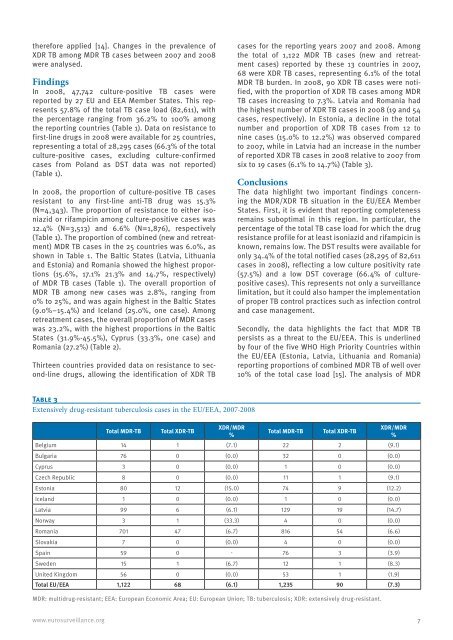Tuberculosis - Eurosurveillance
Tuberculosis - Eurosurveillance
Tuberculosis - Eurosurveillance
You also want an ePaper? Increase the reach of your titles
YUMPU automatically turns print PDFs into web optimized ePapers that Google loves.
therefore applied [14]. Changes in the prevalence of<br />
XDR TB among MDR TB cases between 2007 and 2008<br />
were analysed.<br />
Findings<br />
In 2008, 47,742 culture-positive TB cases were<br />
reported by 27 EU and EEA Member States. This represents<br />
57.8% of the total TB case load (82,611), with<br />
the percentage ranging from 36.2% to 100% among<br />
the reporting countries (Table 1). Data on resistance to<br />
first-line drugs in 2008 were available for 25 countries,<br />
representing a total of 28,295 cases (66.3% of the total<br />
culture-positive cases, excluding culture-confirmed<br />
cases from Poland as DST data was not reported)<br />
(Table 1).<br />
In 2008, the proportion of culture-positive TB cases<br />
resistant to any first-line anti-TB drug was 15.3%<br />
(N=4,343). The proportion of resistance to either isoniazid<br />
or rifampicin among culture-positive cases was<br />
12.4% (N=3,513) and 6.6% (N=1,876), respectively<br />
(Table 1). The proportion of combined (new and retreatment)<br />
MDR TB cases in the 25 countries was 6.0%, as<br />
shown in Table 1. The Baltic States (Latvia, Lithuania<br />
and Estonia) and Romania showed the highest proportions<br />
(15.6%, 17.1% 21.3% and 14.7%, respectively)<br />
of MDR TB cases (Table 1). The overall proportion of<br />
MDR TB among new cases was 2.8%, ranging from<br />
0% to 25%, and was again highest in the Baltic States<br />
(9.0%–15.4%) and Iceland (25.0%, one case). Among<br />
retreatment cases, the overall proportion of MDR cases<br />
was 23.2%, with the highest proportions in the Baltic<br />
States (31.9%-45.5%), Cyprus (33.3%, one case) and<br />
Romania (27.2%) (Table 2).<br />
Thirteen countries provided data on resistance to second-line<br />
drugs, allowing the identification of XDR TB<br />
Table 3<br />
Extensively drug-resistant tuberculosis cases in the EU/EEA, 2007-2008<br />
www.eurosurveillance.org<br />
Total MDR-TB Total XDR-TB<br />
XDR/MDR<br />
%<br />
cases for the reporting years 2007 and 2008. Among<br />
the total of 1,122 MDR TB cases (new and retreatment<br />
cases) reported by these 13 countries in 2007,<br />
68 were XDR TB cases, representing 6.1% of the total<br />
MDR TB burden. In 2008, 90 XDR TB cases were notified,<br />
with the proportion of XDR TB cases among MDR<br />
TB cases increasing to 7.3%. Latvia and Romania had<br />
the highest number of XDR TB cases in 2008 (19 and 54<br />
cases, respectively). In Estonia, a decline in the total<br />
number and proportion of XDR TB cases from 12 to<br />
nine cases (15.0% to 12.2%) was observed compared<br />
to 2007, while in Latvia had an increase in the number<br />
of reported XDR TB cases in 2008 relative to 2007 from<br />
six to 19 cases (6.1% to 14.7%) (Table 3).<br />
Conclusions<br />
The data highlight two important findings concerning<br />
the MDR/XDR TB situation in the EU/EEA Member<br />
States. First, it is evident that reporting completeness<br />
remains suboptimal in this region. In particular, the<br />
percentage of the total TB case load for which the drug<br />
resistance profile for at least isoniazid and rifampicin is<br />
known, remains low. The DST results were available for<br />
only 34.4% of the total notified cases (28,295 of 82,611<br />
cases in 2008), reflecting a low culture positivity rate<br />
(57.5%) and a low DST coverage (66.4% of culturepositive<br />
cases). This represents not only a surveillance<br />
limitation, but it could also hamper the implementation<br />
of proper TB control practices such as infection control<br />
and case management.<br />
Secondly, the data highlights the fact that MDR TB<br />
persists as a threat to the EU/EEA. This is underlined<br />
by four of the five WHO High Priority Countries within<br />
the EU/EEA (Estonia, Latvia, Lithuania and Romania)<br />
reporting proportions of combined MDR TB of well over<br />
10% of the total case load [15]. The analysis of MDR<br />
Total MDR-TB Total XDR-TB<br />
XDR/MDR<br />
%<br />
Belgium 14 1 (7.1) 22 2 (9.1)<br />
Bulgaria 76 0 (0.0) 32 0 (0.0)<br />
Cyprus 3 0 (0.0) 1 0 (0.0)<br />
Czech Republic 8 0 (0.0) 11 1 (9.1)<br />
Estonia 80 12 (15.0) 74 9 (12.2)<br />
Iceland 1 0 (0.0) 1 0 (0.0)<br />
Latvia 99 6 (6.1) 129 19 (14.7)<br />
Norway 3 1 (33.3) 4 0 (0.0)<br />
Romania 701 47 (6.7) 816 54 (6.6)<br />
Slovakia 7 0 (0.0) 4 0 (0.0)<br />
Spain 59 0 - 76 3 (3.9)<br />
Sweden 15 1 (6.7) 12 1 (8.3)<br />
United Kingdom 56 0 (0.0) 53 1 (1.9)<br />
Total EU/EEA 1,122 68 (6.1) 1,235 90 (7.3)<br />
MDR: multidrug-resistant; EEA: European Economic Area; EU: European Union; TB: tuberculosis; XDR: extensively drug-resistant.<br />
7
















